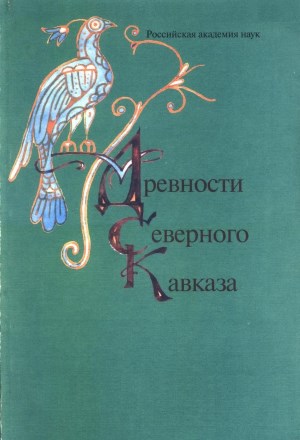 [ сборник ]
[ сборник ]
Древности Северного Кавказа.
// М.: 1999. 214 c.
Отв.ред. В.И. Марковин.
[ аннотация: ]
Книга представляет собой сборник научных работ, подготовленный сотрудниками археологических учреждений Москвы и Северного Кавказа к 70-летнему юбилею профессора Рауфа Магомедовича Мунчаева, директора Института археологии РАН, известного специалиста в области кавказской и ближневосточной археологии. Публикуются и анализируются археологические комплексы Северного Кавказа, датируемые от эпохи энеолита до средневековья, исследуется этнокультурная обстановка, торговые связи, хозяйственная деятельность и религиозно-мифологические представления древних обитателей кавказского региона.
Для археологов, историков, искусствоведов, студентов и преподавателей вузов, всех, интересующихся древней и средневековой историей народов Северного Кавказа.
На обложке: изображение павлина (по мотивам ткани из аланской катакомбы №14 могильного поля у ст. Змейской [Республика Северная Осетия — Алания]).
Содержание
Слово от редактора (В.И. Марковин). — 5
С.Н. Кореневский. Знаковая керамика Кавказа эпохи энеолита и ранней бронзы. — 7
В.И. Марковин. Константиновская группа курганов эпохи бронзы у г. Пятигорска. — 24
О.В. Лопан, В.Е. Маслов. Экажевское поселение — памятник эпохи бронзы в Ингушетии. — 61
М.П. Абрамова. Поселение скифского времени у аула Хумара на Верхней Кубани. — 89
А.Ю. Скаков. Орнаментированные топоры могильника Фаскау в Северной Осетии. — 121
М.П. Мошинский. Браслеты из могильника Гастон Уота (Северная Осетия). — 136
М.С. Гаджиев. Шаракунский клад (Дагестан). — 152
Д.С. Коробов. Новый комплекс из могильника Мокрая Балка I. — 161
В.А. Кузнецов. Аланы и асы на Кавказе (некоторые проблемы идентификации и дифференциации). — 169
И.А. Аржанцева, З.Х. Албегова. Культовые камни Кяфарского городища (ещё раз о религиозном дуализме алан). — 183
И.М. Чеченов, Э.Д. Зиливинская. Мечеть городища Нижний Джулат. — 201
Список сокращений. — 211
Summary. — 212
THE ANTIQUITIES OF THE NORTH CAUCASUS ^
(collected papers)
Edited by Vladimir Markovin.
Summary
This publication is dedicated to the 70th anniversary of Rauf Munchaev, who leads the RAS Institute of Archaeology on the bumpy roads of Russian Science at the times of profound and uneasy changes in this country.
The book contains 11 articles covering an extensive period of time ranging from Bronze Age up to quite late Middle Ages.
The discussion of Bronze Age period artifacts is represented in articles by S.N. Korenevsky (Majkop culture vessels with marks on its bodies and bottoms which are considered as the stage hallmarks by the author), by V.I. Markovin (monographic description of barrows found on Konstantinovskoye plateau near Pyatigorsk which belong to North Caucasus cultural-historical community), by O.V. Lopan and V.E. Maslov (the article presents material on the remains of a settlement near Aekazhevo village in Ingush Republic).
Detailed study of material from Scythian settlement of Khumara (VI-V cc. BC) in Karachaevo-Cherkess Republic is provided in the article by M.P. Abramova.
Ornamented axes and bracelets of the Koban culture found at the cemeteries of Faskau and Gaston Wota in North Ossetia is the subject of the publication by A.J. Skakov and A.P. Moshinsky. Following the description of these items, the authors made an attempt to correctly date them, carrying out a thorough chronological analysis.
Artifacts from a treasure containing coins and other items of Hellenistic period discovered near Sharacun village in Dagestan, is presented by M.S. Gadzhiev in the next article. The author supposes that this treasure may be considered as a trace of an ancient city, probably existed here on a trade route that ran along the Caspian Sea coast.
The article of D.S. Korobov, in its turn testifies in favour of such contacts between ancient local population and Sasanid Iran. The author bases his findings on the material of a complex of finds at the cemetery of Mokraya Balka I site, located near Pyatigorsk.
The book also contains an interesting research on the distinction between two ethnic terms — “the Alans” and “the Asses” that was valid in the Early Medieval period of the history of Caucasus. The first mentioned inhabited the lands along Kuban-river, the other ones resided by Terek-river. It was only much later that the both created a state formation called Alania.
The results of a study of a large number of petrogliphic materials collected during an investigation of Kjafar fortress up Kuban-river are published by I.A. Arzhantseva and Z.Kh. Albegova. Their analysis shows that though professing officially Christianity, the local Alanic population did not actually part with more ancient pagan cults.
In XIII-XIV cc. AD Islam became the prevailing religion on the North Caucasus. I.M. Chechenov and A.D. Zilivinskaya publish here the results of the excavations of a mosque in the fortress of Novy Dzhulat in Kabardino-Balkaria. The data they collected there allows reconstruction of its original architecture.
|